Are you curious about Apple Music Users Statistics? Do you want to understand who uses it, how much money it generates, and where it stands in the competitive world of music streaming?
You’ve come to the right place! This comprehensive guide dives deep into Apple Music’s user statistics for 2025, revealing its impressive growth, market position, and what all of this means for you, the music lover.
Apple Music continues to solidify its position as a powerhouse in the streaming industry. It’s not just a platform; it’s a vibrant ecosystem within the larger Apple universe, offering a rich audio experience to millions globally.
Let’s explore the numbers and uncover the story behind this digital music giant.
Apple Music’s Grand Scale: Key Statistics for 2025

Apple Music shows remarkable growth and strength as we look at 2025. It stands as a formidable competitor in the streaming landscape, constantly innovating and expanding its reach.
Top Picks: Apple Music at a Glance (2025)
| Metric | Value |
| Total Subscribers | Over 94 million |
| Annual Revenue (estimated) | $9.2 billion |
| Gender Demographics (Female) | 56% |
| Contribution to Apple Services Revenue | 6.4% |
| Pay Per Stream | $0.01 (on average) |
| U.S. Market Share | 30.7% |
| Countries Available | 167 |
| Song Catalog | Over 100 million |
| Playlists | Over 30,000 |
These numbers clearly paint a picture of a thriving platform that consistently expands its user base and financial impact.
How Many People Are Tuning In? Apple Music’s Growing User Base
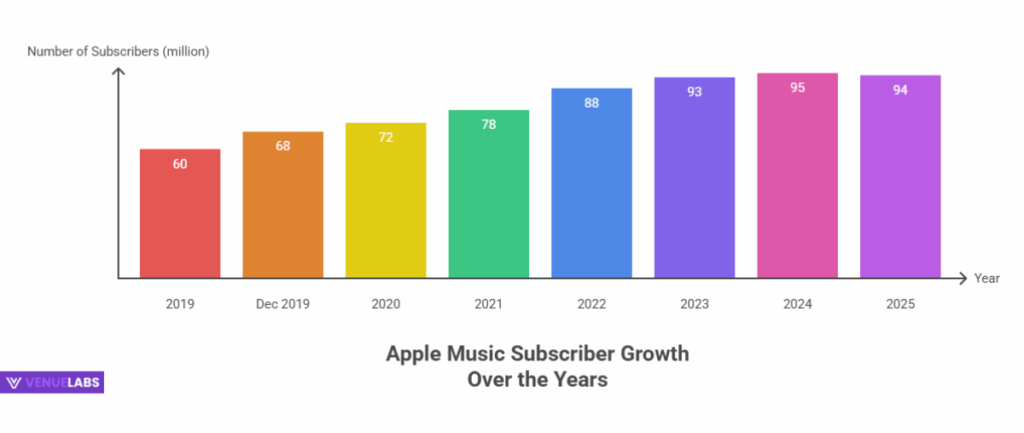
Apple Music’s subscriber count is a testament to its widespread appeal and robust service. In 2025, the platform proudly boasts over 94 million subscribers, reflecting a consistent upward trend. This number has steadily climbed, with a 5.68% increase from 2023 when it had 88 million users.
This significant growth highlights Apple’s effective strategy in attracting and retaining users, even in a highly competitive market. Major redesigns, new features, and seamless integration within the Apple ecosystem all play crucial roles in this success story.
Apple Music Subscriber Growth Over the Years:
| Month-Year | Apple Music Subscribers |
|---|---|
| Jun 2025 | 94 million |
| Jun 2024 | 95 million |
| Jun 2023 | 93 million |
| Jun 2022 | 88 million |
| Jun 2021 | 78 million |
| Jun 2020 | 72 million |
| Dec 2019 | 68 million |
| Jun 2019 | 60 million |
Source: Statista.
You can see the clear trajectory upwards. From 20 million subscribers in late 2016 to nearly 100 million in 2025, Apple Music consistently adds millions of new listeners each year.
- Also read about: iPhone Users Statistics
The Sound of Money: Apple Music’s Revenue Stream
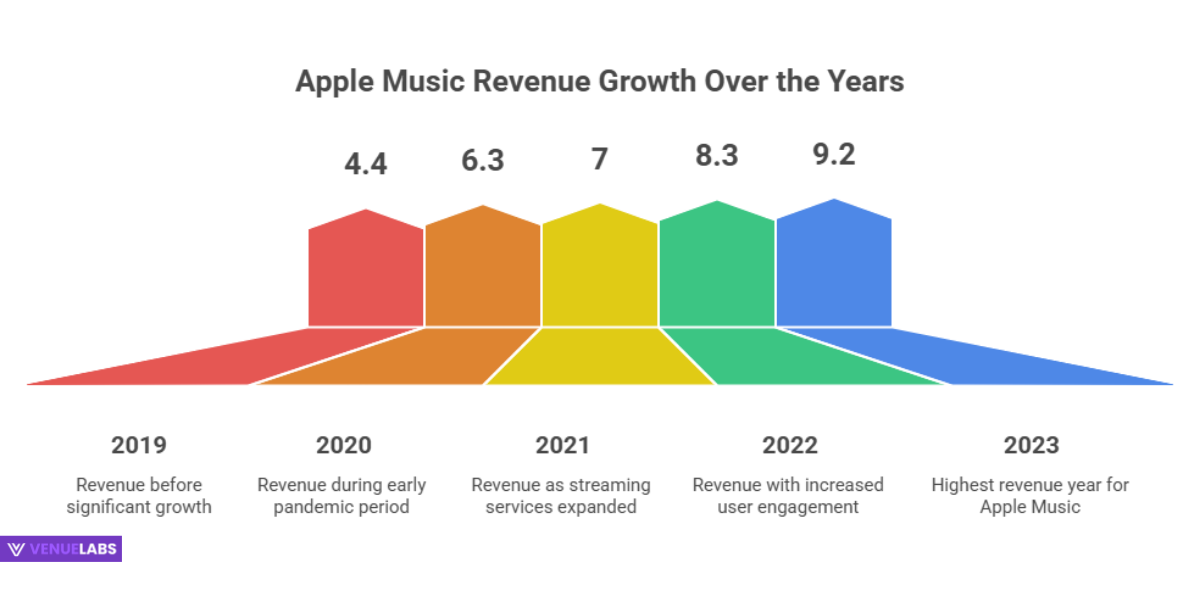
Apple Music is not just about growing its user base; it’s also a significant revenue generator for Apple.
In 2023, Apple Music recorded an impressive $9.2 billion in revenue, representing a healthy 10.84% increase from the previous year. This revenue contributes a substantial 6.4% to Apple Services’ total revenue, which hit $85.1 billion.
This financial performance underscores the immense value that music streaming services, and Apple Music in particular, bring to the tech giant’s overall business model.
Apple Music’s Revenue Through the Years:
| Fiscal Year | Revenue Generated by Apple Music |
|---|---|
| 2023 | $9.2 billion |
| 2022 | $8.3 billion |
| 2021 | $7 billion |
| 2020 | $6.3 billion |
| 2019 | $4.4 billion |
Source: Business of Apps, Statista.
This table clearly illustrates the exponential growth in Apple Music’s financial contributions.
Who’s Listening? Demographics of Apple Music Users
Understanding who uses Apple Music helps us see its broad appeal. The platform attracts a diverse audience, but some trends stand out.
Gender Distribution
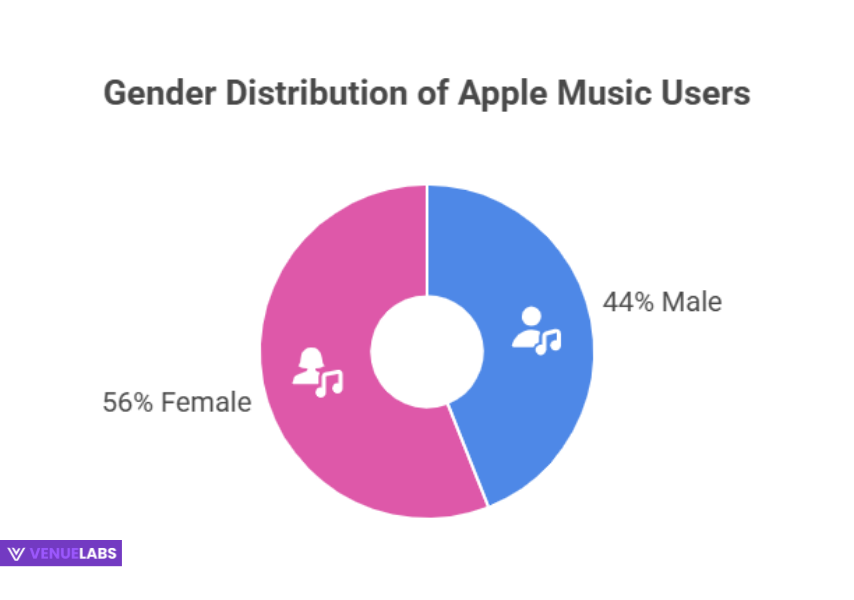
When we look at gender, 56% of Apple Music users identify as female, while 44% are male. This indicates a slight preference among female listeners for Apple’s streaming service.
Apple Music Users by Gender
| Gender | Share of Apple Music Users |
| Male | 44% |
| Female | 56% |
Age Groups
The sweet spot for Apple Music users falls within the 25 to 44 age range, making up a significant 45% of its audience. More specifically, 23% of users are between 25 and 34 years old.
Interestingly, people aged 55 and older also show a strong preference for Apple Music, representing another 23% share in the United States.
Conversely, the 45 to 55 age group uses Apple Music the least compared to other demographics.
Apple Music Users in the United States by Age Group:
| Age Groups | Share of Apple Music Users in the United States |
| 18 to 24 years | 17% |
| 25 to 34 years | 23% |
| 35 to 44 years | 22% |
| 45 to 54 years | 15% |
| More than 55 years | 23% |
Source: Statista
These demographics provide valuable insights for artists and marketers looking to reach specific audiences through Apple Music.
A Global Beat: Apple Music’s Reach Across Regions
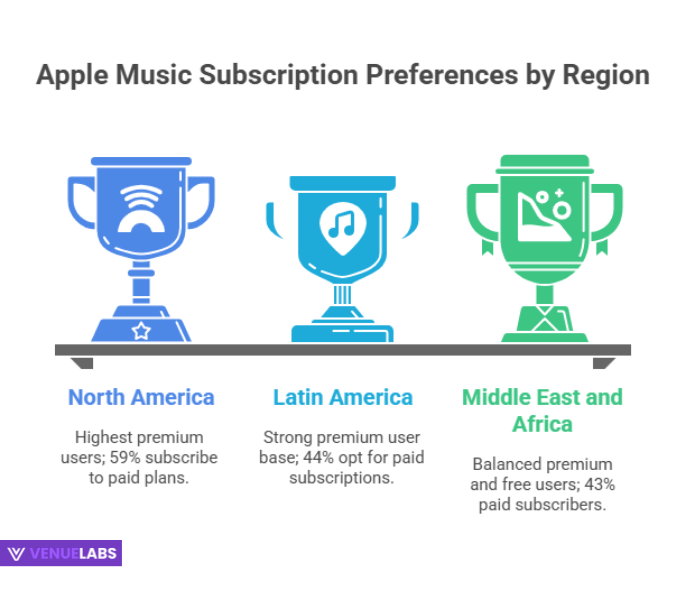
Apple Music’s influence spans the globe, with users in 167 countries. The United States leads with a significant 32.6 million subscribers.
When we look at subscription types, regional differences emerge. North America boasts the highest percentage of premium users, with 59% of its Apple Music audience subscribing to a paid plan.
In contrast, Europe has the highest share of free users, with 64% accessing Apple Music’s free offerings (though it’s worth noting Apple Music primarily focuses on paid subscriptions, this likely refers to trial periods or bundled offers).
Free vs. Premium Apple Music Users by Region:
| Region | Premium Plan Users | Free Plan Users |
| Asia-Pacific | 38% | 62% |
| Europe | 36% | 64% |
| Latin America | 44% | 56% |
| Middle East and Africa | 43% | 43% |
| North America | 59% | 41% |
This regional breakdown highlights where Apple Music is most successful in converting users to paid subscribers and where there might be opportunities for growth in premium offerings.
The Streaming Showdown: Apple Music’s Market Share
In the highly competitive music streaming arena, Apple Music holds its own as the second most preferred platform in the United States, capturing a 30.7% subscriber market share.
This positions it right behind Spotify, which leads with 36%. Apple Music has notably surpassed Amazon Music in subscriber base, cementing its strong market presence.
Music Streaming Market Share (by Subscriber Share):
| Music Streaming Platform | Subscriber Market Share |
| Spotify | 36% |
| Apple Music | 30.7% |
| Amazon Music | 23.8% |
| YouTube Music | 6.8% |
| Pandora Premium | 1.9% |
| Tidal | 0.5% |
| SoundCloud | 0.3% |
This table clearly shows the dominant players, with Apple Music being a close second to Spotify.
The Artists Ruling the Airwaves: Most Streamed on Apple Music
Artists are the heart of any music streaming service, and Apple Music is no exception. As of early 2025, Taylor Swift continues her reign as the most streamed artist worldwide on Apple Music, with her songs accumulating over 72.88 million streams since April 2013.
Following her are global superstars like Ed Sheeran and Billie Eilish, demonstrating the platform’s diverse appeal across genres.
Most Streamed Artists on Apple Music:
| Music Artist | Total Streams On Apple Music |
| Taylor Swift | 72,887,630 |
| Ed Sheeran | 65,208,803 |
| Billie Eilish | 52,288,970 |
| Drake | 50,723,035 |
| The Weeknd | 38,918,341 |
| Post Malone | 38,678,966 |
| Bad Bunny | 36,544,788 |
| Ariana Grande | 35,572,131 |
| Dua Lipa | 35,503,032 |
| 周杰伦 (Jay Chou) | 33,773,534 |
| Harry Styles | 25,998,503 |
| Morgan Wallen | 21,900,893 |
| Justin Bieber | 20,971,933 |
| Olivia Rodrigo | 20,034,500 |
| Travis Scott | 19,927,674 |
| BTS | 19,067,563 |
| Coldplay | 18,785,320 |
| BLACKPINK | 18,229,675 |
| Imagine Dragons | 17,200,465 |
| Doja Cat | 16,967,543 |
These artists drive significant engagement and illustrate the diverse tastes of Apple Music subscribers.
Fair Play: Apple Music’s Pay Per Stream for Artists
Apple Music stands out for its commitment to artists, paying an average of $0.01 per stream. This means that for every time someone plays a song, the artist earns a penny. This rate is notably higher than many of its competitors, including Spotify and YouTube Music.
This higher payout rate stems from Apple Music’s business model, which focuses exclusively on paid subscriptions and does not offer a free, ad-supported tier.
This approach positions Apple Music as a more creator-friendly platform, appealing to artists who seek better compensation for their work.
Pay Per Stream Comparison (Top Music Platforms)
| Music Platform | Pay Per Stream |
| Apple Music | $0.01 |
| Spotify | $0.003 to $0.005 |
| YouTube Music | $0.002 |
This difference can be substantial for artists, making Apple Music an attractive platform for distributing their music.
A Universe of Sound: Songs and Playlists on Apple Music
Apple Music offers an immense library for its subscribers. The platform now hosts over 100 million songs, a number that constantly grows as new music releases daily. This vast catalog ensures that users can find virtually any song they desire.
Beyond individual tracks, Apple Music curates an impressive over 30,000 playlists. These playlists span every genre imaginable, from mood-based selections to artist-curated collections and personalized mixes based on your listening habits. You can always discover new music and rediscover old favorites with such a wide variety.
Apple Music vs. Spotify: The Key Differences

The rivalry between Apple Music and Spotify is a central narrative in the music streaming world. While Spotify boasts a larger overall user base and more downloads, Apple Music continues to carve out a significant share, particularly among premium subscribers.
Apple Music vs. Spotify: A Head-to-Head Comparison (2025 Data)
| Parameter of Difference | Apple Music | Spotify |
| Number of Users | 94 million | 602 million |
| Revenue (2023) | $9.2 Billion | €13.24 billion |
| Pay per stream | $0.01 | $0.003 to $0.005 |
| Subscriber Market Share (2024) | 30.7% | 36% |
| Number of Songs | Over 100 million songs | More than 100 million songs |
While Spotify has a larger free-tier user base, Apple Music’s focus on premium subscriptions and higher artist payouts differentiates its model.
Beyond Music: Apple’s Broader Ecosystem and Its Impact on Apple Music
Apple Music doesn’t exist in a vacuum; it’s an integral part of Apple’s sprawling and highly successful ecosystem. This larger context significantly influences Apple Music’s growth and user engagement.
Apple’s Overall Financial Strength 2025
Apple continues to be an industry-defining powerhouse. In the first quarter of 2025, Apple posted quarterly revenue of $124.3 billion, a 4% increase year-over-year. This immense financial strength provides a solid foundation for all its services, including Apple Music.
Apple Annual Revenue (Historical Growth)
| Year | Apple Annual Revenue |
| 2009 | $42.91 billion |
| 2010 | $65.23 billion |
| 2011 | $108.25 billion |
| 2012 | $156.51 billion |
| 2013 | $170.91 billion |
| 2014 | $182.8 billion |
| 2015 | $233.72 billion |
| 2016 | $215.64 billion |
| 2017 | $229.23 billion |
| 2018 | $265.6 billion |
| 2019 | $260.17 billion |
| 2020 | $274.52 billion |
| 2021 | $365.82 billion |
| 2022 | $394.33 billion |
| 2023 2025(Q1) | $383.29 billion $124.3 billion(in Q1) |
The slight dip in 2023 from 2022’s peak reflects global market challenges but also shows Apple’s resilience and diversification.
Revenue Breakdown: Services Drive Growth
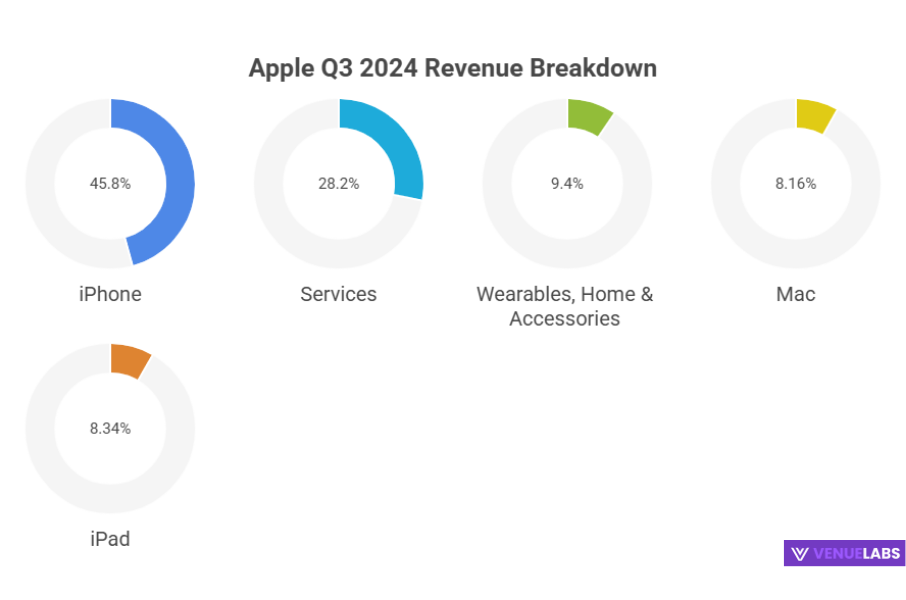
Apple’s revenue diversification is crucial. While iPhones still dominate, the services division, which includes Apple Music, is a rapidly growing segment.
In Q3 2024, Services generated $24.21 billion, making up 28.2% of Apple’s total revenue. This growth underscores the increasing importance of subscription-based offerings like iCloud, the App Store, and, of course, Apple Music.
Apple Revenue Split by Category (Q3 2024)
| Category | Apple Revenue (Q3 2024) | Share of Total Revenue |
| iPhone | $39.29 billion | 45.8% |
| Services | $24.21 billion | 28.2% |
| Wearables, Home & Accessories | $8.09 billion | 9.4% |
| Mac | $7.00 billion | 8.16% |
| iPad | $7.16 billion | 8.34% |
You see here that the services segment is a vital and growing component of Apple’s financial health.
Active Devices: The Foundation of Apple Music’s Reach
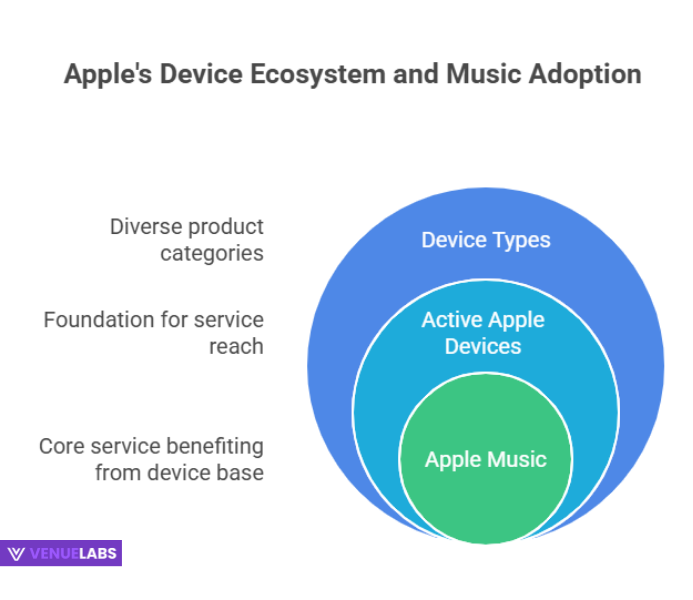
Apple’s immense ecosystem of active devices forms the bedrock for Apple Music’s widespread adoption.
As of 2023, there are around 2.2 billion active Apple devices worldwide, including iPhones, iPads, Macs, Apple Watches, and more. This massive installed base provides a direct pipeline for Apple Music to reach potential subscribers.
Active Apple Devices Worldwide:
| Year | Active Apple Devices |
|---|---|
| 2019 | 1.50 billion |
| 2020 | 1.65 billion |
| 2021 | 1.90 billion |
| 2022 | 2.05 billion |
| 2023 | 2.20 billion |
The seamless integration of Apple Music across these devices offers a cohesive and convenient user experience, which is a major draw for customers.
What Users Are Asking: Insights from Quora and Reddit
Beyond the statistics, real users on platforms like Quora and Reddit often highlight specific pain points or desires. Here are some common themes and insights:
- Lossless Audio & Spatial Audio: Many users rave about Apple Music’s inclusion of Lossless Audio and Spatial Audio with Dolby Atmos at no extra cost. They frequently ask how to best optimize their listening setup (e.g., what headphones to use, settings adjustments) to fully experience these high-fidelity features. This shows a growing demand for premium audio quality.
- Discovery and Curation: While Apple Music offers many playlists, users sometimes express a desire for even more personalized discovery tools, comparing it to Spotify’s highly refined algorithms. They often ask for tips on how to “train” Apple Music’s recommendations or find niche genres.
- Cross-Platform Experience: While strong within the Apple ecosystem, some users on Reddit, especially those with Android devices or Windows PCs, occasionally discuss minor frustrations with the cross-platform experience, seeking workarounds or improvements for a more seamless integration outside of Apple hardware.
- Library Management: Power users often ask for more robust tools for managing large personal music libraries, including advanced tagging, smart playlist capabilities, and easier ways to integrate their own uploaded music with Apple Music’s catalog.
- Social Features: Compared to Spotify’s more prominent social sharing options (like Wrapped and collaborative playlists), some Apple Music users express a wish for enhanced social features to connect with friends and share music more directly within the platform.
These discussions show that while users love Apple Music, they also have specific hopes for future enhancements, particularly around advanced features and social interaction.
How You Can Benefit from Apple Music’s Strengths
As an Apple Music user or someone considering subscribing, understanding these statistics helps you appreciate the platform’s value and how to maximize your experience:
- Immerse Yourself in High-Fidelity Audio: With Lossless and Spatial Audio included, you access superior sound quality. Invest in compatible headphones or speakers to truly elevate your listening experience.
- Explore a Vast Library: With over 100 million songs, you always find new music. Dive into the 30,000+ curated playlists or create your own to organize your discoveries.
- Support Your Favorite Artists: Knowing Apple Music pays artists more per stream means your subscription directly contributes to the creators you love more significantly than on other platforms.
- Enjoy Seamless Integration: If you own other Apple devices (iPhone, iPad, Mac, Apple Watch), Apple Music offers an incredibly smooth, integrated experience. Your music, playlists, and listening history sync effortlessly across all your devices.
- Personalized Discovery: Although users ask for more, Apple Music’s “For You” section and personalized radio stations do a great job of recommending music based on your taste. Actively “heart” songs you love and “dislike” those you don’t to refine your recommendations.
- Offline Listening: Save your favorite songs and playlists for offline access, perfect for commutes, travel, or areas with poor internet connectivity.
The Future of Apple Music
Looking ahead, Apple Music is poised for continued growth. Its strong financial backing, massive installed device base, and commitment to high-quality audio position it well against competitors.
We can expect further innovations in personalization, artist interaction, and possibly even more robust social features to cater to evolving user demands.
FAQs About Apple Music Users Statistics
1. How many people use Apple Music in 2025?
As of 2025, Apple Music has over 94 million subscribers worldwide, showing consistent growth in its user base year-over-year.
2. Is Apple Music more popular with a specific age group or gender?
Yes, the majority of Apple Music users fall into the 25 to 44 age bracket, accounting for 45% of its audience, with 56% of its users identifying as female.
3. How much revenue does Apple Music generate for Apple?
Apple Music generated an estimated $9.2 billion in revenue in 2023, contributing 6.4% to Apple Services’ total revenue, and its financial impact continues to grow.
4. Does Apple Music pay artists more than other streaming services?
Yes, on average, Apple Music pays artists $0.01 per stream, which is a higher rate compared to many of its competitors, including Spotify and YouTube Music.
5. What is the main competitive advantage of Apple Music?
Apple Music’s main competitive advantages include its seamless integration within the vast Apple ecosystem, its extensive catalog of over 100 million songs, and its commitment to high-fidelity audio options like Lossless and Spatial Audio included in the subscription price.
Also Read:
- Internet User Statistics
- Google Ads Statistics
- Latest Digital Marketing Statistics
- Affiliate Marketing Statistics
- Smartwatch Statistics
Conclusion: Apple Music’s Powerful Position in 2025
Apple Music stands strong in 2025, boasting over 94 million subscribers and generating $9.2 billion in revenue. It commands a significant 30.7% market share in the U.S. and pays artists a leading $0.01 per stream.
With a vast catalog of over 100 million songs, advanced audio features like Lossless and Spatial Audio, and seamless integration within Apple’s massive ecosystem, the platform provides immense value to its users.
The ongoing discussions among users reveal a desire for even deeper personalization and social connectivity, areas where Apple Music can further innovate.
As a central pillar of Apple’s growing services division, Apple Music not only shapes the future of digital music but also offers a rich, high-quality experience for music lovers worldwide.
